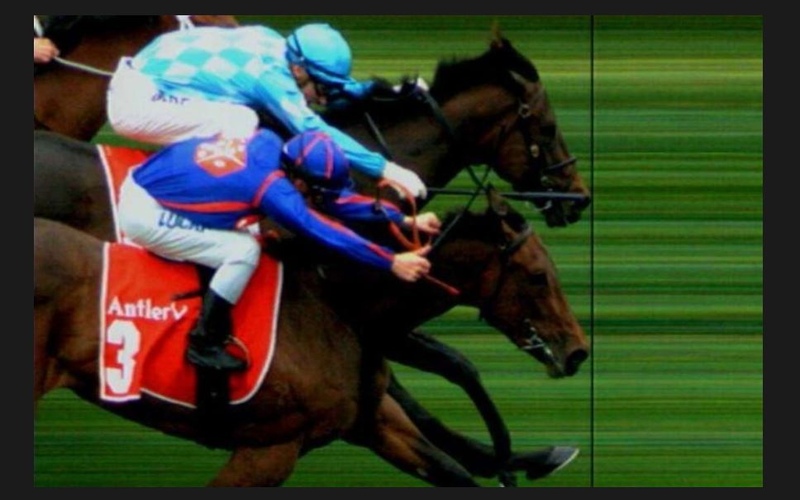
A dead heat is when two or more participants in a given event tie. This is different to a draw in that the tie will not have featured on the original betting options. The application of dead heat rules occasionally varies slightly from bookmaker to bookmaker and sport to sport but can often lead to a smaller payout than the bettor was expecting if they are unaware of the rule.
The rule itself is very simple and means that only a certain portion of your bet is classed as a winning bet. In the event of two (for example) horses, finishing in a dead heat, half your stake is settled as a winner and half as a loser whilst if three horses cannot be separated just one third of the stake wins, with the majority being settled as a losing bet.
Dead heats in horse racing are perhaps the simplest form of a dead heat and it is quite straightforward to understand the underlying logic. If the horses cannot be separated, even by a photo finish, then the bookie has to pay out on both of them as winners, however, as effectively they “shared” the win, the bookie only pays out on the half that has been deemed to have won.
However, dead heat rules can apply to a variety of sports and markets and one of the more common ones is each way bets in golf. If you back a player each way, with the place part paying ¼ the odds for a top four finish, your player can finish second and yet you may still not get the full payout you were expecting. If the player finishes joint second, tied with six other golfers (an unlikely but far from implausible scenario) then effectively those golfers can be classed as finishing second through to eighth inclusive. Only second, third and fourth are winners, whilst fifth, sixth, seventh and eighth have lost. As such, despite finishing joint second, only three sevenths of the stake will be classed as winning, the majority being settled as a losing bet.
A simpler example may concern betting on who the top scorer in the Premier League or a major tournament will be. At the 2012 Euros, six players tied on three goals for the top goalscorer and so several punters who expected good returns on the likes of Alan Dzagoev, Mario Gomez and Fernando Torres actually may have returned less than their stake as five sixths of the bet was actually settled as a loser. This matter was confused further by the differential between the top scorer and the Golden Boot award, Torres wining the latter due to his assist and limited playing time. Any bets placed on the Golden Boot would settle Torres as sole winner but as almost all bookmakers priced up top scorer we saw a six-way dead heat.
Like most things in life, the dead heat rule is simple when you know about it so whenever you place a bet that could involve a tie, be aware that you may not always win, even if your selection finishes first.
Calculating A Dead Heat Payout
 The first thing to note is that dead heat rules are used uniformly by all UK betting sites, so you will not find better terms at one bookie than another or be treated differently according to who you bet with. Where a market states “Dead heat rules apply” (this will be listed either alongside the market or in the specific rules for the sport involved), these will be the same rules whoever you place your bet with.
The first thing to note is that dead heat rules are used uniformly by all UK betting sites, so you will not find better terms at one bookie than another or be treated differently according to who you bet with. Where a market states “Dead heat rules apply” (this will be listed either alongside the market or in the specific rules for the sport involved), these will be the same rules whoever you place your bet with.
But how is your payout calculated using these rules? Well, as we have detailed, a dead heat is where two or more players, runners, teams or anything else cannot be separated in an event. To explain how your winnings are worked out, let us imagine the simplest dead heat possible, one where two horses cross the line at exactly the same time in a race.
The two cannot be separated even using the ultra-accurate dead-heat technology that now exists and so the race is declared a dead heat. This, as we shall discuss shortly, is not especially common these days, but one relatively recent and high profile example occurred when Epatante and Not So Sleepy could not be separated in the 2021 Fighting Fifth Hurdle at Newcastle.
There were just six runners in the race and Epatante was a strong favourite at odds of 11/8, with Not So Sleepy not so fancied out at 18/1. The latter defied that big price to run a stormer and just got up at the line to force a dead heat. So, what happened to bets on either horse? Dead heat rules applied but what, in reality – in hard currency – did this mean?
Well, the calculation itself is very simple, and could possibly even be done by a horse (step forward Clever Hans). OK, maybe not a horse, but certainly most humans.
You simply take the number of participants involved in the dead heat, in this case two. You then divide your stake by that number and then multiply it by the full, normal odds. So dead heat rules differ from each way bets (where it is the odds that are reduced, whilst the full stake is maintained). This makes the calculation easier but can make the results less pleasing because you actually lose some of your bet.
So had you placed £10 on Epatante at 11/8, that £10 would be divided by two (as there were two horses involved in the dead heat). £5 would be paid out at odds of 11/8 but the other £5 of the stake is lost, as effectively Epatante only “half won”, with Not So Sleepy also half winning. So your £10 bet on Epatante to win would see you get £11.88 back and mean you were just £1.88 up, despite your horse winning, at least in a sense.
Had you backed Not So Sleepy, the same calculation would apply, so if you had made the same £10 bet, the bookie would keep £5 but pay you out for a £5 winner at 18/1. As such, had you backed the overachieving underdog, your returns would have been £95, leaving you £85 to the good.
What About A 3-Way Tie?
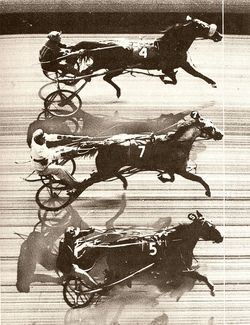 Three-way ties are very uncommon in horse racing, though not unheard of; but they are certainly far from a freak occurrence when it comes to each way golf betting, something we will look at in a moment. However they occur, the key issue a punter will be concerned with is how their winnings will be calculated. The same dead heat rules and the same calculation apply.
Three-way ties are very uncommon in horse racing, though not unheard of; but they are certainly far from a freak occurrence when it comes to each way golf betting, something we will look at in a moment. However they occur, the key issue a punter will be concerned with is how their winnings will be calculated. The same dead heat rules and the same calculation apply.
As such, let us imagine in that same Fighting Fifth race that the horse who came third (third, not second) actually finished at exactly the same time as Epatante and Not So Sleepy, creating a three-way dead heat. Sceau Royal, who in reality was just a length and a half back, was priced at 9/2 and if you had placed £10 on the French nine year old to win, you would have got £18.33 back if he had been level with the other two, leaving you £8.33 better off than when you started.
Your £10 stake would have been divided into three, representing the three horses that effectively all one-third won. £3.33 at 9/2 returns that same £18.33 (or £18.32 depending on how the bookie rounds things). However, what would have happened to a punter who backed the favourite in this scenario? They would actually have made a loss on the race, despite landing the “winner”.
That short price of 11/8 is insufficient to compensate for the loss of two thirds of the stake and with just a third of their stake winning at 11/8, Epatante backers would have returned just £7.92 from a three-way dead heat. It might seem harsh to actually lose money despite no horse beating yours but that is simply the way dead heat rules work, as the bookie has to pay out on multiple horses, rather than just a single winner.
Dead Heats And Each Way Bets

Once again, we will come to the example of each way golf bets and dead heats in due course (pun intended). First though, let us explain how they work in more general terms, as they can apply to horse racing and other sports too. There are a number of variables that can affect the payout but to start with, and to keep things nice and simple, let us imagine that you had placed an each way bet on Not So Sleepy as above at odds of 18/1.
As we have said, there were just six runners in this race, which means the standard each way terms would have been two places and a quarter of the odds. A £10 each way bet on Not So Sleepy would have cost £20 and returned £150, and to understand why let us look at both parts of the each way wager.
The £10 on the 18/1 shot to win is subject to dead heat rules in the same way as we have described above. As such, £5 wins and is paid at 18/1, returning £95, whilst half the stake loses. We then have to consider the £10 place part of the bet and how, or if, the dead heat affects this.
In this scenario, the dead heat does not affect the place payout because our pick has effectively finished half first and half second. The next horse in the race, Sceau Royal, was third, so Not So Sleepy has fulfilled the place part of the bet fully. As such you would receive a quarter of the 18/1 odds for your full £10 (place) bet, returning an additional £55, taking the total up to £150 and meaning you finish £130 up.
As we have said, there are many variables so if we return to our hypothetical scenario where the Fighting Fifth ended as a three-way dead heat, we can see how things would change. In this situation, the win part of the bet is again calculated in the same way, with the stake divided by three. So £3.33 of the win part of the bet is paid at 18/1, returning £63.33.
The place part of the bet in this case is also affected by the dead heat as Not So Sleepy is effectively sharing the top three places. The next horse (which was Silver Steak) would be listed as fourth, so in one sense we could say that our pick finished a third in first, a third in second and a third in third. The third that came third in the race is outside the each way terms, which covers the top two places only, so this means that only two thirds of the each way stake has won. In simple terms, we take the number of places available, in this case two, and divide it by the number of entrants involved in the dead heat, in this case three.
So once again, we take two thirds of the stake, so now £6.67, and this is paid at a quarter of the standard 18/1 odds. This gives a return on the place part of the bet of £36.69 and an overall return of £100.02, meaning you have cleared over £80.
How Common Are Dead Heats?
As we have noted, thankfully the reality is that dead heats are quite rare in the general scheme of things. Depending on which sports and markets you wager on and how often you place bets, you may never be affected by a dead heat. On the other hand, those who bet very regularly on horse racing and who make weekly each way bets on the golf are probably going to see dead heats many times a year.
Dead Heats In Horse Racing
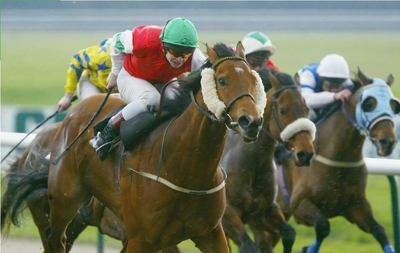 Dead heats in horse racing are far less common than they used to be thanks to the brilliant photo-finish technology that can now separate horses who, to the naked eye, appear to have finished in a tie. In the days of yore, it was merely the naked eye, perhaps observing the breaking of a finishing tape, that was the only tool we had. As such, where horses were very close, a dead heat would be declared.
Dead heats in horse racing are far less common than they used to be thanks to the brilliant photo-finish technology that can now separate horses who, to the naked eye, appear to have finished in a tie. In the days of yore, it was merely the naked eye, perhaps observing the breaking of a finishing tape, that was the only tool we had. As such, where horses were very close, a dead heat would be declared.
If we go right back to the earliest days of the sport there was of course no photography and certainly no video. As such the decision of the course official, or placing judge, stationed at the line would be final and there would be no scope to review the decision. This might seem mighty strange now given the endless replays we witness in most sports but that was the way it was and if the official believed the horses had finished at the same time, a dead heat would be declared.
Photo-finishes have been used for longer than one might think, since 1881 in fact. However, the technology and set-up in those days were rudimentary to say the least. This improved dramatically from the 1930s and 1940s onwards to try and combat corruption in the sport but in today’s money it is thought that those systems would have cost around £2.5m.
The technology has come a long way since then, getting far cheaper and improving dramatically and continues to do so, but is said to be a “continuous work in progress”. Changing sports briefly, and Usain Bolt’s 2008 Olympic Games performance was captured by a camera that produced 3,000 images per second, compared to previous cameras that used “just” 1,000.
Anyway, switching back to horse racing, we can see that in modern times dead heats occur on average a few times a season if we look at major global racing. The stats around dead heats when we attempt historical comparison are not hugely helpful as we do not have full and wide-ranging information on dead heats, certainly not on a global scale.
Because of this, it might appear that we are actually witnessing more dead heats in the modern era when, in fact, this is unlikely to be the case. Even relatively recently, at the end of the 20th century, information about dead heats in minor races from France, Ireland or the US – and even from the UK – are probably incomplete.
No matter what, overall it is safe to say that dead heats in horse racing are very, very rare. It is estimated that around 10,000 races a year take place in the UK and we would normally see between one and five dead heats in those races. Looking at one of the biggest races of them all, the Epsom Derby, we can see that there have been just two dead heats in the entire history of the race, dating back to 1780. In the 2,000 Guineas we have seen only one, in 1868, whilst in the St Leger, the oldest Classic of them all, we have had a mere two since 1776.
Dead heats in National Hunt races are even rarer because these contests tend to be far longer than the action on the Flat and so close finishes are less frequent. The most iconic NH race of them all, the Aintree Grand National, has never seen a dead heat in almost 200 years. The Gold Cup at the Cheltenham Festival is much younger but it too has never witnessed two horses crossing the line at exactly the same time.
Dead Heats In Other Sports
![]() As we have seen, dead heats in horse racing are very rare, statistically speaking. Whilst the Wikipedia page on such matters may list eight for 2021 (though none for 2020 or 2019) it should be remembered that this is from tens of thousands of races around the world. But what of other sports?
As we have seen, dead heats in horse racing are very rare, statistically speaking. Whilst the Wikipedia page on such matters may list eight for 2021 (though none for 2020 or 2019) it should be remembered that this is from tens of thousands of races around the world. But what of other sports?
Well, if anything, dead heats are even rarer in other sports. This is partly because of the structure and nature of many sports. For example, tennis matches are always played until there is a winner. Meanwhile, if a football game ends level, it is declared a draw and given how common this is it is very different from a dead heat. Many sports use some form of tie-breaker to separate teams or participants that might otherwise be said to be in a dead heat.
Be it extra time, a play-off, a super over, extra innings, or something else, the sports themselves mean that a dead heat from both a sporting and betting perspective is out of the question. Indeed, in the past, horse racing did this too and some of the dead heats referred to above were actually settled by a second race.
Dead heats are most commonly associated with racing sports but there has never been a dead heat in Formula 1. This is mainly because the drivers race for around two hours, so they can usually be separated, whilst in addition there are relatively few races per year. With just 20 or so Grands Prix per season, they are clearly going to occur less frequently than horse racing and that sport’s 10,000+ contests per year.
Dead Heats In Greyhound Racing
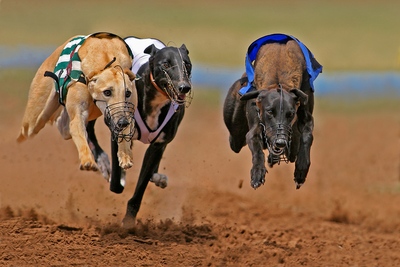 Greyhound racing is the obvious sport to look to for dead heats given its similarities with horse racing. That said, the fact that the vast majority of dog races have just six runners does rather reduce the chance of a dead heat occurring. However, greyhound meetings feature far more races than their equine equivalent and the Greyhound Star reported that amid the recent global health crisis there were 40,000 races and even that was down around a third on the year before. So there are probably between four and six times as many dog races in the UK each year as there are horse contests.
Greyhound racing is the obvious sport to look to for dead heats given its similarities with horse racing. That said, the fact that the vast majority of dog races have just six runners does rather reduce the chance of a dead heat occurring. However, greyhound meetings feature far more races than their equine equivalent and the Greyhound Star reported that amid the recent global health crisis there were 40,000 races and even that was down around a third on the year before. So there are probably between four and six times as many dog races in the UK each year as there are horse contests.
Incredibly, in 2011 we even saw a triple dead heat among dogs, this incredible “30 million to one” occurrence happening at Romford when Killishan Masai, Ayamzagirl and Droopys Djokovic all crossed the line at the same time. This was the first time the sport had ever seen three dogs “tie” which is not hugely surprising given that equates to half the field!
More recently we saw a dead heat in a relatively high-profile race, the 2019 semi-final of the Irish Derby. That such stories make the news shows just how uncommon dead heats are in the sport. There are no collated stats regarding the precise frequency with which they occur. However, we would certainly say that as a punter it is not something you need to really factor into your thinking, given they do occur very infrequently indeed.
Famous Dead Heats
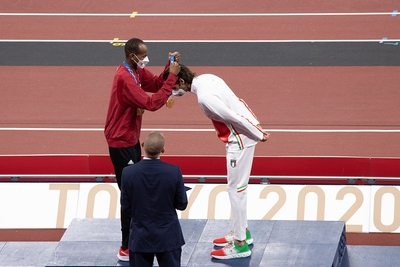
In sport, it is human nature that fans and those involved normally want to see winners and losers and so, typically, some form of tiebreaker means we do not often get dead heats. However, we have a couple of examples of dead heats that made the news for different reasons.
One heart-warming story of a dead heat occurred quite recently at the 2020 Olympic Games (held in 2021 in Tokyo), when high jumpers Gianmarco Tamberi and Mutaz Barshim agreed with officials that they would share gold rather than take part in the customary jump off. The two athletes, already friends, evoked the true spirit of the Games by agreeing to share gold rather than continue to compete.
Betting on the Olympic high jump is not hugely popular and we suspect there was not a vast amount of money (if any) wagered on either athlete. However, if there was, it would probably have been subject to dead heat rules. That said, had the bookies not stated that dead heat rules would apply, not realising such an eventuality was possible, they may have had to pay out on both high jumpers.
Perhaps a higher profile example of a sporting dead heat, and certainly one where significant money is wagered, concerned the top goalscorer award at the 2010 football World Cup. This incident really brought the concept of a dead heat home to many punters, especially people who tended to only bet on football, rather than horse racing as well, and who might not have previously been aware of the rule.
Thomas Muller, David Villa, Wesley Sneijder and Diego Forlan all finished the World Cup in South Africa as joint-top scorers on five goals. There was huge variation in their odds, with Villa towards the top of the betting at single-figure odds, Muller a bit longer and the latter two real outsiders, with Forlan at 66/1 for example.
Top goalscorer is one of the few football markets where a dead heat is a possibility but many punters who backed one of the above four players were unaware of it. Anyone who bet specifically on “top goalscorer” or “to score most goals” or similar would have been, or certainly should have been, subject to dead heat rules.

In contrast, if the market offered was for the Golden Boot, then only bets on Muller would have paid out as winners. This is because the Golden Boot is an official FIFA award, first created in 1982 (then as the Golden Shoe), and this has a tiebreaker mechanism to separate players who finish level. In Muller’s case, he was the winner of the Golden Boot as he had the most assists (in the event of a tie on that metric, the player who had played the fewest minutes would be the winner).
This tournament and in particular the outcome of this market, made many punters far more aware of the implications of dead heats. If you backed Muller (£10) at 8/1 for top goalscorer, the four-way dead heat would see only £2.50 of your stake win, returning £22.50. On the other hand, had you backed him to win the Golden Boot at the same price (some bookies may have had different odds for this market) you would have got £90 back.
On the other hand, £10 on Forlan at 66/1 would return a very tidy £167.50 in the top goalscorer market but would have been a losing wager, returning nothing, for the Golden Boot. There were also implications with regards to each way bets (only offered for top scorer) as these would typically pay based on three places.
One of the key things to note is that dead heats in this market, and other similar ones, are not at all uncommon. In USA 1994 two players were level on goals, whilst if we go back to Chile and 1962, six players finished as joint-top scorers on four goals, legendary Brazilian Garrincha among them. More recently four players were tied for the award at Euro 92, two at Euro 2000 and Euro 2020 and, incredibly, Cristiano Ronaldo was one of six players to finish on three goals at the head of the Euro 2012 charts.
Closer to home, in 2018/19 we saw three players share the Premier League Golden Boot, which does not have any form of tiebreaker, with Sadio Mane, Mo Salah and Pierre-Emerick Aubameyang all managing 22 goals. Dead heats are rare in all sports but they are not so rare that you should not at least understand how the rule works.
Dead Heats And Each Way Golf Bets

Having said that dead heats are unusual in all sports and markets, let us now look at a sport where we never see a dead heat from a sporting perspective and yet, at the same time, see them frequently from a betting one. As we have alluded to, when it comes to golf, there are no dead heats for first place as there is always a tournament winner. Extra holes, a play-off, are used to separate any two, or more, players that finish level.
From a sporting perspective, when players finish on the same score lower down the leaderboard, they simply tie. So if two players tie for second, their tournament record shows T2, tied for second. They simply split the prize money and ranking points of second and third equally between them. The same applies for all ties, so if eight players finish joint 20th, they split the prize money and points for places 20 to 27 inclusive and all are listed as T20 in the record books.
With around 150 players taking part in a standard tournament, ties for various places are commonplace. Ties for 20th have no impact, ties for first are decided with a play-off but what about ties for the each way places?
Such ties bring dead heat rules into play on a very frequent basis. It would be a stretch to say this happens every week but certainly if we look at both the PGA and European Tours and consider that bookies pay each way to a varying number of places, it is definitely a factor many times a season.
Let’s take the 2022 Wells Fargo. The top of the leaderboard can be seen below:
| Position | Player | Score |
|---|---|---|
| 1 | Max Homa | -8 |
| T2 | Keegan Bradley | -6 |
| 5 | Rory McIlroy | -4 |
| T6 | Lanto Griffin | -3 |
| T6 | Stephan Jaeger | -3 |
| T6 | Anirban Lahiri | -3 |
Many sites might have been paying each way places down to sixth on this event, where we have a three-way tie. Some might have even paid to seven places, and either way dead heat rules would come into play. If we assume your betting site was paying six places then you would be paid based on a third of your stake, whilst if we assume seven, it would be two thirds.
You can get large ties for first place, and for other places, that have an even bigger impact. There has been a six-way play-off on the PGA Tour on three occasions. This occurred at the 2021 Wyndham Championship, when Kevin Kisner ultimately prevailed.
Keven Na, Adam Scott, Branden Grace, Roger Sloan and Si Woo Kim all finished tied for second, with three players next in T7. Depending on your bet and how many places were being paid (if you made an each way wager) there were various possible outcomes. For example, a straight win bet on one of the five golfers that made the play-off but didn’t win would return zero. Even an each way bet with a bookie that only paid four or five places would be affected, whilst anyone backing one of the trio that was tied seventh would only receive a part payout unless their each way bet was based on nine or more places.
When it comes to each way golf betting and dead heats it really is crucial that you understand the rules. This is because the large fields in golf, and the high number of each way places many sites pay, means that they will frequently be invoked. If you take a look back at almost any of the significant events on the main tours you will see that almost all involve a number of ties in and around the traditional number of places being paid (from four to eight).
In some instances, there may be many players in a tie, with, for example seven players sharing seventh at the 2021 US Open and a massive nine players tying for eighth at the PGA Championship that year. If your selection was in a tie for eighth but dropped a shot on the last they would drop down to 17th. Even if they had managed to hang on, assuming your bookie paid to eight places you would only be paid based on £1 in every £9 you staked! Forewarned is forearmed and at least if you understood dead heat rules you would know why your payment was far less than you might otherwise expect.
